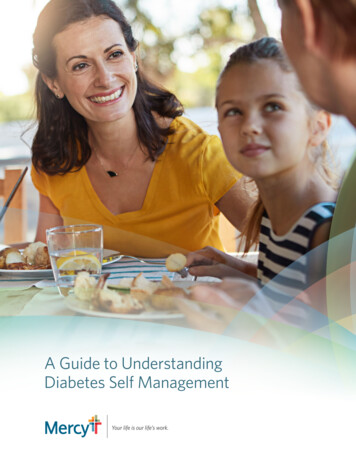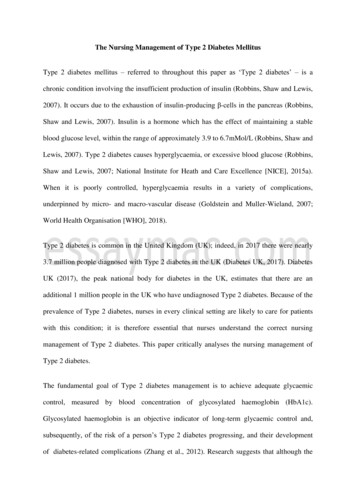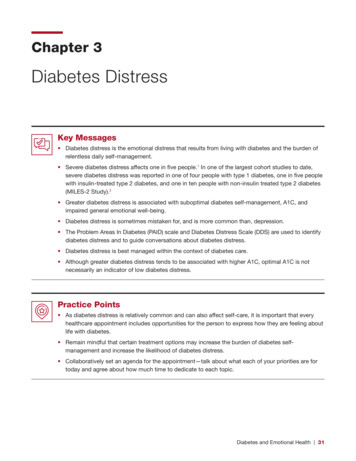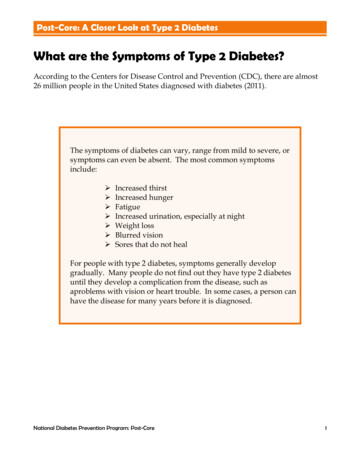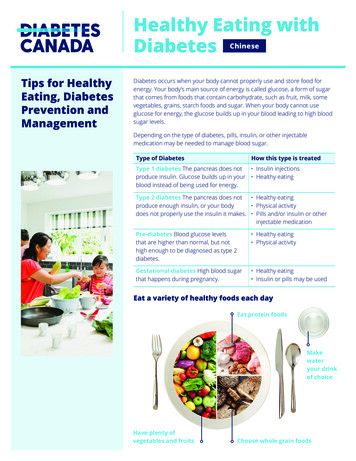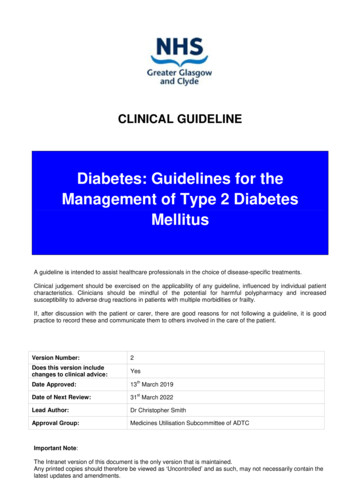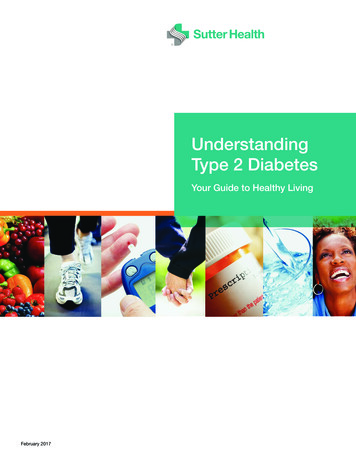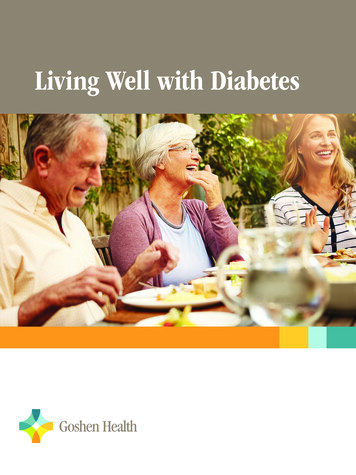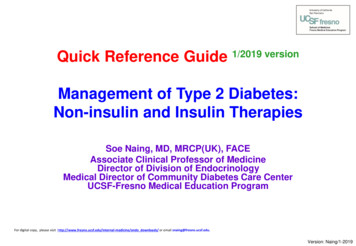
Transcription
Quick Reference Guide 1/2019 versionManagement of Type 2 Diabetes:Non-insulin and Insulin TherapiesSoe Naing, MD, MRCP(UK), FACEAssociate Clinical Professor of MedicineDirector of Division of EndocrinologyMedical Director of Community Diabetes Care CenterUCSF-Fresno Medical Education ProgramFor digital copy, please visit http://www.fresno.ucsf.edu/internal-medicine/endo downloads/ or email snaing@fresno.ucsf.edu.Version: Naing/1-2019
1Naing/1-2019
2Naing/1-2019
Management of Type 2 Diabetes : Overview3Intensive Lifestyle Modification†Mild hyperglycemiaA1c 8%Monotherapywith metforminModerate hyperglycemiaA1c 8-10% or A1c 1.5% above targetSevere hyperglycemiaA1c 10% orRandom BG 300 mg/dl orFasting BG 250 mg/dlDual therapyMetformin 2nd agent*Triple therapyMetformin 2nd 3rdagent*Insulin therapySee page 4 and 7asymptomaticSevere symptomsWeight lossDKA/Hyperosmolar stateSevere infection/surgeryIf A1c is not at goal in 3 months, move to next step.† healthy eating, increased physical activity, weight loss, and referral to a diabetes center for self-management education and medical nutrition therapy* A patient-centered approach should be used to guide the choice of glucose-lowering medication. Considerations include the patient- and drug-specific factors,efficacy, cost, benefit, risk, patient’s characteristics and patient’s preference. (see page 5)Naing/1-2019
4Overview of Insulin Therapy (Basic)See page 7 for insulin initiation and titration guide.Step 1One injection daily(basal insulin)Step 2Two injections daily(Basal 1 regimen orPre-mixed insulin)Step 3Add GLP-1 ReceptorAgonistto basal insulinMultiple injections daily(Basal Prandial therapy)If A1c is not at goal in 3 months, move to next step.Naing/1-2019
Pharmacological Therapy of Type 2 Diabetes : Comparison of Glucose-Lowering Medications5Use this table to choose a class of medication – Consider the factors in first column, that will impact the medication choice.5 Majorgroups12ClassesInsulin sulin ProvidersInsulin NoNoWEIGHTLoss (modest)GainGainGainASCVD PotentialASCVDbenefitPotentialASCVDbenefit withpioglitazone.Uncertaincardiovascular safetyUncertaincardiovascular safetyYesInsulinGlinidesCOSTCEMIA RISKGLP1-based therapyLow (NPH/R)α GlucosidaseInhibitorsBile NeutralPreferred addon(Lira- orSema-glutide)Preferred add-on(Empa- or Canagliflozin)NeutralNeutral? ASCVDeventsNeutral CHF Riskwith Saxa- &Alo-gliptinPreferred addon (Lira- orSema-glutide)if SGLT2i contraindicated1st choicepreferred add-on(Empa- or Canagliflozin)if eGFR is adequateLinagliptin –no need toadjust dose.Others – toreduce dose.Preferred addon (Lira- orSema-glutide)if SGLT2i contraindicated1st choicepreferred add-on(Empa- or Canagliflozin)if eGFR is adequateAvoid ifeGFR 30No doseadjustmentneededNo doseadjustmentneededNo doseadjustmentneeded0.4 to 0.5%0.4 to 0.7%0.4 to 0.6%YesEfficacy( A1c)1 to 2%High1 to 1.5%High1 to 2%High1 to 1.5%HighNo “ceiling”Highest0.6 to 0.8%Intermediate0.5 to 1.6%High0.5-0.9% eGFR dependentIntermediate to experience Postmealglucoseexcursions.UniversalResponseWell tolerated Postmealglucoseexcursions. BP Postmealglucoseexcursions. LDL-COtherrisksNauseaDiarrheaLacticacidosisB12 Edema Fracture risk? Bladdercancer? MacularedemaWeight gainHigh rate ofsecondaryfailureWeight gainFrequentdosingWeight gainAngioedemaUrticaria? Pancreatitis? Arthralgia? BullouspemphigoidNauseaVomiting Heart rate?PancreatitisMedullarythyroid cancerin animalsGU tract infection K, DehydrationHypotension, DKA, LDL, Cr (brief) risk ofamputation/fracturewith CanagliflozinFlatulenceDiarrheaConstipation TriglycerideMay absorption ofotherMedicationseGFR 30AcidosisHypoxiaDehydrationNYHA III/IVheart failureSevere renalor hepaticimpairmentUse withcaution inpatients with ah/opancreatitis.PMH or FH ofMEN2/Medullarythyroid cancerCaution in h/opancreatitis orgastroparesis.Renal ighNo doseadjustmentneeded(see page 15for dose anddetails)DopamineAgonistHighYesRepaglinidecan be usedin advancedCKD/ESRD.SGLT2 InhibitorsContraindicated if eGFR 30Do not start orto reducecurrent dose ifeGFR 45.CKD AvoidGlyburide(See page 15)GLP-1ReceptorAgonistsOthers (less popular)High CHF riskCHF DPP4InhibitorsGlucose AbsorptionInhibitorLower dosesrequired ifeGFR See page 15 for dose & detailsBenefit in NASH HDLActive bladdercancerHepaticimpairment(See above CKD rowand page 15)Low to Intestinalobstruction.TG 500mg/dlh/o of eatitis.OralSQ ncopeDizzinessNausea, iabeticgastroparesisNaing/1-2019
Pharmacological Therapy of Type 2 Diabetes : Comparison of Glucose-Lowering Medications6Use this table to prescribe a medication from the class chosen in previous table5 Brand name)Insulin e,Fortamet,Glumetza)Minimum –Maximumdose&DosingFrequency500mg qd1000 mg bidAvailablestrength500, 850,1000 mgThiazolidi-nedionePioglitazone(Actos)Actos15-45 mg qdInsulin ProvidersInsulin x)Glipizide2.5-20 mgbid/acGlimeperide1- 8 mg qamGlyburidePrandin0.5-4 mgtid/acStarlix60-120 mgtid/acGLP-1 (Glucagon-like Peptide-1)-based therapyInsulinMeal insulin:Novolog/Fiasp,Humalog/Admelog, Apidra,Humulin/Novolin RAfrezza inhalorBasal insulin:Lantus/Basaglar/Toujeo/, Levemir,TresibaHumulin/Novolin NNo maximumdose1.25-20mgqamActos15, 30,45 mgGlipizide5, 10 mgGlimeperide1, 2, 4 mgGlyburide1.25, 2.5, 5mgDPP4InhibitorsPen:3ml (300 Units)Vial:10ml (1000 Units)Metformin and TZD can beused TH ACTOS:Actoplus Met XR(Actos Metformin)15/1000, 30/1000mg qam (XR)15/500, 15/850 mg bid (generic)Duetact (Actos Amaryl)30/2, 30/4 mg qamOseni (Nesina Actos)(12.5 or 25) (15 or 30 or 45 mg)qamDo not use Sulfonylurea andGlinides together.α GlucosidaseInhibitorsBile AcidSequestrantDopamine2 tine(Cycloset)Pramlintide(Symlin)0.8-4.8 tide (Victoza),Lixisenatide (Adlyxin),Dulaglutide (Trulicity)Semaglutide tro)AcarboseJanuviaAll sq injections:Byetta 5-10 mcg bid/acVictoza 0.6-1.8 mg qamAdlyxin 10-20mcg qamBydureon or BydureonBcise 2 mg qwTrulicity 0.75-1.5 mg qwOzempic 0.25-1.0 mgqwInvokana100-300 mg qamFarxiga5-10 mg qamJardiance10-25 mg qamSteglatro5-15 mg qamPrecose orGlycet25-100 mgtid/ac625-1250mg tidByetta 5,10mcgVictoza 0.6, 1.2, 1.8 mgAdlyxin 10, 20mcgBydureon or BydureonBcise 2 mgTrulicity 0.75, 1.5 mgOzempic 0.25, 0.5, 1.0mgInvokana100, 300 mgFarxiga5, 10 mgJardiance10, 25 mgSteglatro5, 15mgPrecose orGlycet25,50,100 mg625 mg25-100 mg qamOnglyza2.5-5 mg qamTradjenta5 mg qamNesinaJanuvia25,50,100 mgOnglyza2.5, 5 mgTradjenta5 mgNesina6.25,12.5,25 mgCombinationSGLT2InhibitorsOthers(less Linagliptin(Trajenta),Alogliptin(Nesina)6.25-25mg qamPrandin0.5, 1, 2 mgStarlix60,120 mgGLP-1 ),Miglitol(Glyset)Do not use DPP4 inhibitors and GLP1 RAtogether.WITH DPP4 inhibitor:JanuMet XR (Januvia metformin)50/500, 50/1000, 100/1000 mg qamKombiglyze XR(Onglyza metformin)2.5/1000, 5/500, 5/1000 mg qamKazano (Nesina metformin)12.5/500, 12.5/1000 mg bidOseni (Nesina Actos)(12.5 or 25) (15 or 30 or 45 mg) qamJentadueto (Tradjenta metformin)2.5/500, 2.5/850, 2.5/1000 mg bid15-120mcgtid/ac0.8 mg15, 120mcg penWith mealinsulin onlyWITH a basal insulin:WITH SGLT2 inhibitor:XultophyDegludec (Tresiba) liraglutide (Victoza)Invokamet XR (Invokana metformin)50 or 150/500, 50 or 150/1000 mg qamSoliquaglargine (Lantus) lixisenatide (Adlyxin)Synjardy XR (Jardiance met)Xigduo XR (Farxiga met)5 or 10/500, 5 or 10/1000 mg qam5 or 10 or 12.5 or 25/1000 mg qamGlyxambi (Jardiance Tradjenta)10/5, 25/5 mg qamQtern (Farxiga Onglyza)10/5mg qamNaing/1-2019
Management of Type 2 Diabetes : Guide for Insulin Initiation and TitrationStep 1Insulin regimensStarting doseOne injection dailywith a basal insulinBasal insulin therapy:Start 0.2 Unit/kg body weightor 10 units QHS.To cont’ metformin, GLP1 RA othernon-insulin agentsAdd GLP1 RA.Move to step 2 or 3If A1c is not at goal.Step 2Two injections dailywith Basal 1 regimen orPre-mixed insulinTo cont’ metformin. Considerstopping other non-insulin agents.(Lantus/Toujeo/Basaglar, Levemir, Tresiba or NPH)Basal 1 regimen:Add one dose of prandial insulinbefore main meal of the day.Start 0.1 U/kg, 4 units or 10% of current basal dose.Pre-mixed insulin therapy:Change basal insulin to pre-mixed insulin bid/ac.Divide current basal dose into ½ AM ½ PM or ⅔AM ⅓ PM orStart 0.5 U/kg in 2 divided doses.For patients on basal insulin or basal 1 regimen:Add prandial insulin before each meal or tid/ac.Start 0.1 U/kg, 4 units or 10% basal dose per mealMultiple injections dailywith Basal Prandial TherapyTo cont’ metformin. Considerstopping other non-insulin agents.TitrationPatients may adjust the dose by 1 unit every night orby 3 units or 10-15% every 3 nights until target fastingBG of 80-130 mg/dl is achieved.Consider adding prandial insulin if A1c is not at goalthough the patient has been taking at least 0.7-1.0unit/kg of basal insulin or fasting BG has been at goal.Patients may adjust the prandial insulin doseby 1 unit every day or by 2 units or 10-15% every 3days until 2 hours post-meal BG of 100-160 or nextpre-meal BG of 80-130 is achieved.(Novolog, Fiasp, Humalog, Admelog, Apidra or Human insulin R)(Novolog 70/30, Humalog 75/25 or human insulin 70/30)Step 37For patients on Pre-mixed insulin therapy:Use 80% of current total daily dose and give50% as basal insulin 50% as prandial insulin in 3divided doses.For insulin-naïve patients:Start total daily insulin dose of 0.5 U/kg and give 50% asbasal insulin 50% as prandial insulin in 3 divided doses. orStart basal insulin 0.2 U/kg prandial insulin 0.1 U/kg tid/acBreakfast dose:Patients may adjust the dose by 1 unit every day orby 2 units or 10-15% every 3 daysuntil pre-dinner BG of 80-130 mg/dl is achieved.Dinner dose:Patients may adjust the dose by 1 unit every day orby 2 units or 10-15% every 3 daysuntil fasting BG of 80-130 mg/dl and/or bed-time BG of130-180 mg/dl is achieved.Consider giving pre-mixed insulin tid/ac if bid/ac fails.Patients may adjust the prandial insulin dose by 1 unitevery day or by 2 units or 10-15% every 3 daysuntil 2 hours post-meal BG of 100-160 mg/dl or nextpre-meal BG of 80-130 mg/dl is achieved. Once insulin is initiated, the physician should readjust thedose by 10-20% every 1-2 weeks and/or advise the patientto self-titrate the dose until BG targets are met. For hypoglycemia, determine the cause and reduce thecorresponding dose by at least 10-20%.Naing/1-2019
8Tips for successful insulin therapy NO SLIDING SCALE INSULIN Start conservatively and adjust frequently Maintain “50%-50% ratio” rule for basal and prandial insulin doses Firstly, lower the fasting BG with the basal insulin.– Consider adding prandial insulin when basal insulin dose is 0.7-1.0 U/Kg.– Adjust the dose frequently until the desired FASTING BG (usually 80-130) is achieved. Secondly, lower the post-meal BG with the prandial insulin.– Try to match carbohydrate amount and prandial insulin dose Fixed prandial insulin dose with consistent amount of carbohydrate (consider using a platemethod) Flexible prandial insulin dose based on Insulin-to-Carbohydrate Ratio (ICR) (consider using a smartphone app for carb counter)– Adjust the dose frequently until the desired 2-H post-meal BG (usually 160) or nextpre-meal BG (usually 80-130) is achieved. Prandial insulin is for carbohydrate, and it should be given before a meal basedon the meal (carbohydrate) size. Do not base on pre-dose BG level.– No meal no prandial insulin– Smaller meal lower dose of prandial insulin– Larger meal higher dose of prandial insulinNaing/1-2019
9Overview of Insulin Therapy (Advanced)To use together with next page # 10Step 1Step 22 to 3 injections dailywith“Basal 1” or “Basal 2” regimen1 injection dailywith a basal insulin2 to 3 injections dailywith Pre-mixed insulinbid/ac or tid/acAddGLP-1 Receptor Agonistto basal insulin2 ways to match carbohydrate amount and prandial insulin doseStep 3Multiple injections dailywith Basal Prandial TherapySimplemethodAdvancedmethodStep 4Severe insulin resistance orhigh insulin dose ( 150 Units daily)Humulin R U-500 concentrated insulinbid/ac or tid/ac (see page 10)Fixed prandial insulin dose before each mealandconsistent amount of carbohydrate (plate method)Flexible prandial insulin dose before each mealbased onInsulin-to-Carbohydrate Ratio (ICR) (see page 10)Flexible prandial insulin dose before each mealbased onICR and Insulin Sensitivity Factor (ISF) (see page 10)INSULIN PUMPNaing/1-2019
Supplement to "Overview of Insulin Therapy (Advanced)" at page 910Insulin-to-Carbohydrate Ratio (ICR) based on body weight in LbsPatient’s weight in LbsICR ratio100-1091:16 (1 unit insulin for 16 grams carb)110-1291:15 (1 unit insulin for 15 grams carb)130-1391:14 (1 unit insulin for 14 grams carb)140-1491:13 (1 unit insulin for 13 grams carb)150-1691:12 (1 unit insulin for 12 grams carb)170-1791:11 (1 unit insulin for 11 grams carb)180-1891:10 (1 unit insulin for 10 grams carb)190-1991:9 (1 unit insulin for 9 grams carb) 2001:8 (1 unit insulin for 8 grams carb)(carbohydrate in grams)
11STANDARD OF MEDICAL CAREIN DIABETES ontent/42/Supplement 69
12STANDARD OF MEDICAL CARE IN DIABETES pplement 69Naing/1-2019
American Association of Clinical Endocrinologists : 2018 Comprehensive Type 2 Diabetes Management etes-algorithm-executive-summary.pdf13Naing/1-2019
American Association of Clinical Endocrinologists : 2018 Comprehensive Type 2 Diabetes Management abetes-algorithm-executive-summary.pdfNaing/1-2019
15
Bcise 2 mg qw Trulicity 0.75-1.5 mg qw Ozempic 0.25 -1.0 mg qw Invokana 100-300 mg qam Farxiga 5-10 mg qam Jardiance 10-25 mg qam Steglatro 5 15 mg qam Precose or Glycet 25-100 mg tid/ac 625-1250 mg tid 0.8-4.8 mg qam sq injection 15-120 mcg tid/ac Available strength 500, 850, 1000 mg Actos 15, 30, 45 mg Glipizide 5, 10 mg Glimeperide 1, 2, 4 .
